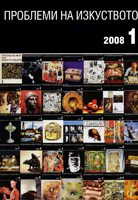Инфраструктура на художествения живот и художествени процеси
The Infrastructure of the Artistic Life and Artistic Processes
Author(s): Chavdar PopovSubject(s): Cultural history
Published by: Институт за изследване на изкуствата, Българска академия на науките
Summary/Abstract: This work defends the viewpoint that terminology such as the „artistic life“ and the „artistic process“ do not represent „metaphysical“ definitions that have been fixed once and for all and that immanently exist as part of the development of visual-sculptural art throughout all eras and in all circumstances. Rather, they should be used with substantiated reasons and applied only on the basis of an analysis of concrete historical, social and pan-cultural circumstances. This article examines certain structural characteristics of the historical existence of artistic life as a definite system of public factors and institutions that create the necessary conditions for the functioning of visual-sculptural art in the contemporary world. These general particularities correspond to the specific characteristics of the historical development of the social life of art in Bulgaria. In this light, certain periods can be delineated in which such infrastructure does not exist (such as the period before the country’s national liberation in 1878), as well as periods that display a distinct deficit of the fundamental signs and attributes of artistic life (from the 1950s to the 1970s). There are also simultaneously situations such as the present, in which we tend toward the restoration of the fullness of its functioning. The conclusion is reached that the current state of the „art scene“ in Bulgaria, despite its undeveloped and largely rudimentary character, represents to a certain degree (keeping in mind all caveats and negative aspects) a process of „normalization“ and getting in line with the „world of art“ in Bulgaria using the typology of the global Art World. At the same time, doubts are raised as to the existence of a distinct „artistic process,“ understood as an expression of „organizedness“ and „normality.“ New directions are not subjected to some overarching „received“ program, as in the directed character of art during Socialism. In this light, certain characteristic changes in the status of the artist and the art critic are analyzed, as is the emerging and developing art market.
Journal: Проблеми на изкуството
- Issue Year: 2008
- Issue No: 1
- Page Range: 31-36
- Page Count: 6
- Content File-PDF

